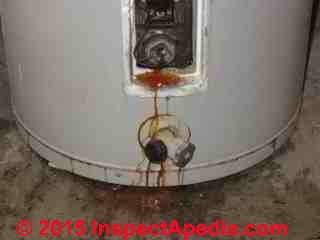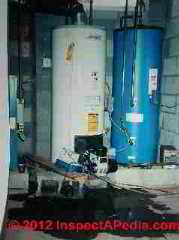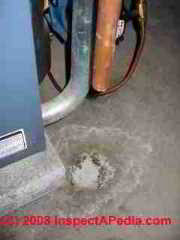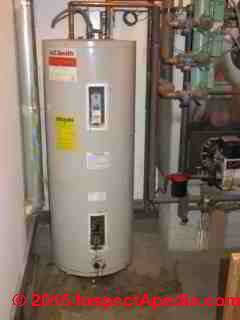 Water Heater Leak Diagnosis & Repair
Water Heater Leak Diagnosis & Repair
Find & fix leaks at water heaters, calorifiers, geysers, cylinders
- POST a QUESTION or COMMENT about the types of leaks that occur at water heaters, where they are found, what problems the leaks cause, and repairing leaky heaters, calorifiers, geysers, cylinders,
Water heating equipment leaks, corrosion, & repair procedures:
How to find the source of a water heater leak: which hot water heater leaks can be fixed and when is a new heater (calorifier) needed?
Here we explain the types of leaks that occur at water heaters, how to tell them apart, and we describe which heater leaks can be repaired. 5
In this article series we explain how to diagnose and fix water heater problems, leaks, or hot water quantity or temperature. Page top photo: leaks visible at an electric water heater appeared to be just below the bottom heating element but were traced to the tank itself.
InspectAPedia tolerates no conflicts of interest. We have no relationship with advertisers, products, or services discussed at this website.
How to Find, Diagnose & Fix Leaks at a Water Heater
 Leaks at water heaters, also referred to as calorifiers, geysers, and hot water cylinders, can seep away for a long time before anyone notices.
Leaks at water heaters, also referred to as calorifiers, geysers, and hot water cylinders, can seep away for a long time before anyone notices.
Of these water heating equipment leaks, most can be repaired, except for leaks in the water heater tank itself.
But if you wait too long, any leak can cause enough damage to make the water heater (geyser) unsafe or un-repairable.
Our photo shows a big water puddle on the floor where two water heaters are installed.
[Click to enlarge any image]
How to Find a Leak at the Water Heater or Geyser
There are three common clues that lead you to a leak at the water heater in your building:
1. A puddle on the floor around or near the water heater is an obvious water heater leak but not always. Depending on when and under what conditions the leak occurs, when you look around the water heater the puddle may be a metre away from the heater or even more, with dry floor between puddle and the heater.
I see this condition when a heater leaks only under certain conditions, such as when it's at its hottest. The heater leaks, water runs on to the floor, across to collect in a low spot. By the time you inspect the heater the area of floor between the leak source and the puddle may have dried.
2. Sizzling or hissing sounds at a water heater, geyser, calorifier, cylinder are usually caused by either condensation on the burner or by water leaks in the heater that are dripping onto the burner.
I discuss sizzling sounds at the water heater below on this pafe.
3. No hot water: stumbling growling out of a cold shower and late for work you stop to look at the water heater:
The problem could be with a control or burner, or the trouble could be that leaks have shut down a gas burner or even shorted an electrical component or control.
Check first: Check that the water heater has fuel or if it's electric, that it has electrical power. If yours is a gas fired water heater and IF the heater uses a temperature-operated automatic gas shutoff valve, that safety device could have shut down your system.
If you have no hot water and there is no evidence of a leak at your water heater, see HOT WATER PRESSURE LOSS - sudden loss of hot water supply in a building.
Details about the installation, testing, and functions of gas automatic shutoffs are at GAS WATER HEATER AUTOMATIC SHUTOFF
Find the Point of Leak at the Water Heater: That Determines the Needed Repair
Watch out: take care to find the actual leak point at the water heater as the type of leak has different and important implications.
 Temperature/Pressure Relief Valve Leaks at a Water Heater
Temperature/Pressure Relief Valve Leaks at a Water Heater
Watch out: A leaky temperature pressure relief valve is unsafe as it can clog with scale and top leaking, risking a BLEVE explosion.
A TPR valve will leak due to a variety of causes including obvious ones: excessive pressure, excessive temperature, or because of an internal failure, or because of less obvious causes such as thermal expansion or even water hammer.
Usually you can trace a puddle of water on the floor to a leaky relief valve by observation of dripping at the valve's extension tube opening or by feeling inside that opening to find that it is wet. Take care to avoid getting scalded.
Or you may see not a wet spot but just a stain where water has been dripping out of the relief valve (as in our photo).
Temperature & Pressure Relief valves may open, leak, or drip for a variety of reasons that we list and explain in detail
Also
see THERMAL EXPANSION TPR VALVE LEAKS and for a cure of that problem
Leaks at Water Heater Connections, Pipes, Valves
A leaky control valve or plumbing connection above or near the water heater or at the water heater drain valve itself can also be the source of a puddle on the floor near the heater - a repair that also merits help from your plumber but does not normally mean that the water heater itself is in trouble.
But take care to fix leaks dripping onto or into the water heater as those can both wet the insulation and damage the heater, possibly making it unsafe.
SeeLEAK TYPES, WATER SUPPLY or DRAIN PIPES for help tracking down hard-to-find plumbing system leaks.
Also see LEAK CAUSES in WATER PIPING
 Leaks at the Actual Water Heater Tank
Leaks at the Actual Water Heater Tank
A leaky water heater tank can be more difficult to diagnose as the point of leakage may be hidden.
First eliminate leaky relief valves or plumbing fittings. Inspect each threaded or soldered or crimped plumbing connection at the water heater for water or for corrosion or deposits that would indicate a history of leaks.
Then look closely at all of the tappings into the water heater tank body, including the cold water in and hot water outlet pipes, the sacrificial anode mounting point, the relief valve mount point, at the drain valve, and on an electric water heater, check the mounting points for the heating elements and thermostatic controls.
If none of these fittings are leaky then most-likely the water heater tank itself has failed and the heater will need to be replaced.
Our photo shows a wet floor around an electric calorifier (water heater).
This is the same heater shown in a close-up photo at the top of this article. This heater had to be replaced.
Check the bottom of the water heater: The bottom of the interior of gas or oil fired water heaters can be inspected (with power and fuel supply shut off) through the burner opening using a light and an inspection mirror.
Look for rust, cracks, scale formation and drip marks on the under side of the heater's tank above the burner.
Corrosive water supplied to a building also will shorten the life of a water heater. See CORROSIVITY or ACIDITY of WATER.
Condensation vs Actual Water Heater Leaks
In our article on water heater noises we
describe SIZZLING WATER HEATER sounds
- a clue that warns you of a problem with water dripping onto a gas burner. That water may be from condensation or from an actual water leak somewhere on the heater.
I distinguish that sizzling sound that tends to be intermittent and in response to drops of water falling onto a hot burner
from HISSING WATER HEATER
- hissing is more-continuous and is more-likely to be heard at an electric water heater - also described in our article on water heater noise.
You can distinguish between a water heater condensation problem and a leaky water heater by a few simple steps [adapted and expanded from advice in the A.O. Smith bulletin cited below. ]
1. Set the water heater gas control to "PILOT" - only the pilot remains lit, or if the water heater uses an automatic igniter rather than a pilot flame, turn the water heater gas supply completely OFF.
2. Wipe up any water on the floor around the heater and under it as much as you can get up. Take a look at the burner assembly to note if it looks very wet - you will compare its appearance with that given in the next step.
3. Wait at least eight hours, allowing the heater to cool down and also allowing time for water from a small heater leak to show up under or around the heater. Then inspect for water under the heater, around it, and on or at the burner.
4. Inspect for water: If there is no water around the heater, the problem you found may be due to condensation. Since condensing should not occur when the water heater is heated to 115 degF or above, check the temperature settings of your heater and also see if there's a relation between the appearance of condensate on the floor and long periods during which the heater was not in use.
You're more likely to see a condensation problem in very cold weather when incoming water to the heater was very cold and the heater was used, re-filled, then was not used for an extended time.
If there is water around the water heater after you left it off overnight or longer then you need to make a closer look for an actual water leak. Leaks at fittings can often be repaired but a leak from a rusted hole in the water heater tank or a leaky tank seam are not repairable.
See AOS Bulletin 15 CONDENSATION [PDF] retrieved 2017/11/17 original source: https://www.hotwater.com/lit/bulletin/bulletin15.pdf
See AOS Bulletin 51 PUDDLE ON FLOOR [at the water heater] [PDF] retrieved 2017/11/17, original source: https://www.hotwater.com/lit/bulletin/bulletin51.pdf
Leaks at Tankless Coils on Boilers
Leaks at tankless coil water heaters are discussed separately
at TANKLESS COIL / HOT WATER COIL LEAKS
Leaks at Indirect or Tankless Water Heaters
Question: can a leak be repaired with a tankless heater still attached to the wall?
Can a leak normally be repaired with the unit still attached to the wall?
Does one remove the pipes inside of the heat exchange of the tankless water heater? Are there parts for such items. My unit is Nakagki. Small water leak so far. - rwrusso@msn.com 9/6/11
This question was posted originally at TANKLESS COIL / HOT WATER COIL LEAKS
Reply:
The type of tankless coil we discuss here is a part that inserts into a heating boiler; It can't be repaired if it's leaking, but the entire assembly can be replaced; It's a significant job - the boiler has to be drained;
You seem to be asking about a stand alone tankless water heater, not part of a home heating boiler.
Those are discussed separately under TANKLESS WATER HEATERS
The heat exchanger coil in those units is replaceable too; the heater shell can usually remain attached to the building but the cover is removed and a bit of disassembly will be required.
...
Continue reading at WATER HEATER LIFE or select a topic from the closely-related articles below, or see the complete ARTICLE INDEX.
Or see these
Recommended Articles
- ANODES & DIP TUBES on WATER HEATERS
- ELECTRIC WATER HEATER INSPECTION CHECKLIST
- ELECTRIC WATER HEATER REPLACEMENT
- HOT WATER EXPANSION TANKS
- INDIRECT WATER HEATER LEAKS
- INDIRECT WATER HEATER REPAIR
- LEAK CAUSES in WATER PIPING
- LEAK TYPES, WATER SUPPLY or DRAIN PIPES
- RELIEF VALVE LEAKS
- TANKLESS COIL / HOT WATER COIL LEAKS
- TANKLESS WATER HEATERS
- THERMAL EXPANSION TPR VALVE LEAKS
- WATER HEATER AGE & MANUALS
- WATER HEATER LIFE
- WATER HEATER RESET BUTTONS & CONTROLS
- WATER HEATER SAFETY
Suggested citation for this web page
WATER HEATER LEAK REPAIR at InspectApedia.com - online encyclopedia of building & environmental inspection, testing, diagnosis, repair, & problem prevention advice.
Or see this
INDEX to RELATED ARTICLES: ARTICLE INDEX to WATER HEATERS
Or use the SEARCH BOX found below to Ask a Question or Search InspectApedia
Ask a Question or Search InspectApedia
Try the search box just below, or if you prefer, post a question or comment in the Comments box below and we will respond promptly.
Search the InspectApedia website
Note: appearance of your Comment below may be delayed: if your comment contains an image, photograph, web link, or text that looks to the software as if it might be a web link, your posting will appear after it has been approved by a moderator. Apologies for the delay.
Only one image can be added per comment but you can post as many comments, and therefore images, as you like.
You will not receive a notification when a response to your question has been posted.
Please bookmark this page to make it easy for you to check back for our response.
Our Comment Box is provided by Countable Web Productions countable.ca
Citations & References
In addition to any citations in the article above, a full list is available on request.
- John Cranor [Website: /www.house-whisperer.com ] is an ASHI member and a home inspector (The House Whisperer) is located in Glen Allen, VA 23060. He is also a contributor to InspectApedia.com in several technical areas such as plumbing and appliances (dryer vents). Contact Mr. Cranor at 804-873-8534 or by Email: johncranor@verizon.net
- In addition to citations & references found in this article, see the research citations given at the end of the related articles found at our suggested
CONTINUE READING or RECOMMENDED ARTICLES.
- Carson, Dunlop & Associates Ltd., 120 Carlton Street Suite 407, Toronto ON M5A 4K2. Tel: (416) 964-9415 1-800-268-7070 Email: info@carsondunlop.com. Alan Carson is a past president of ASHI, the American Society of Home Inspectors.
Thanks to Alan Carson and Bob Dunlop, for permission for InspectAPedia to use text excerpts from The HOME REFERENCE BOOK - the Encyclopedia of Homes and to use illustrations from The ILLUSTRATED HOME .
Carson Dunlop Associates provides extensive home inspection education and report writing material. In gratitude we provide links to tsome Carson Dunlop Associates products and services.

